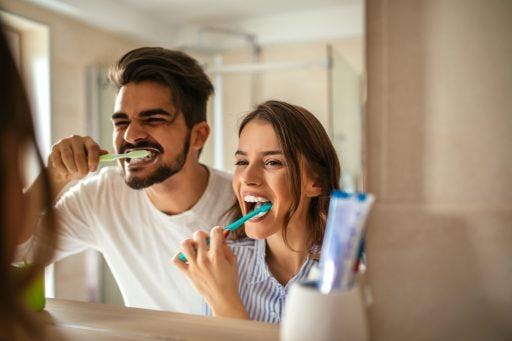A latte in the morning, doughnuts after lunch, and ice cream before bed. Sugar is a delight to your taste buds but a real threat to your teeth. It’s a bitter fact that sweet food is not the best friend you’ve always thought it was. While it momentarily elevates your happy hormone, it attracts destructive bacteria in your mouth that cause more work for you – and your dentist.
But in the wise words of Selena Gomez, the heart wants what it wants. Going cold turkey on sugar is unrealistic and makes you crave it even more. The best news is that you can satisfy your sweet tooth without risking oral health. Before that, let’s uncover the bad news: what sugary treats can do to your teeth.
Dental Problems Related to Sweet Food

“Too much candy will rot your teeth!” You may have heard this warning from your parents. And, unfortunately, it’s not an old wives’ tale.
An Australian health survey reports that the average Australian consumes 60 grams of sugar daily – double the recommended 25 grams. To put things into perspective, a single serving of soda contains roughly 40 grams of free sugar.
Sweet food affects your teeth in many ways. For example, plaque forms when molecules in sugary snacks merge with bacteria in your mouth and saliva. Beyond that, the bacteria in plaque also use sugar to generate acids. These acids break down the enamel, making your teeth weaker and susceptible to cavities.
Research in Scientifica also reveals that sugary beverages decrease the salivary pH level in less than 15 minutes. According to further studies, saliva with a pH level lower than 7 creates a conducive environment for tooth decay and gum disease (periodontitis).
How to Protect Your Smile (Without Ditching Sugar)
All these facts seem to steer you away from indulging in sweet food. Limiting your sugar intake to almost zero is the healthiest approach, sure, but not the easiest. How else are you going to brave through a breakup without a box of chocolate?
Almost every food and drink contain sugar, even fresh fruits. So whether you advocate the “There’s always room for dessert” philosophy or enjoy fresh juice every morning, follow these tips to maintain oral health.
1. Set a dessert time.
Which one is better: taking several spoonsful of cake at different times of the day or eating a whole slice in one sitting? If you answer the latter, you’re correct! Every time you eat sugar, no matter how small the amount is, the plaque bacteria begin their enamel-corroding acid production. For example, if you drink bubble tea a few hours after taking a nibble of cake, the cycle starts again and increases your risk of cavities.
2. Pick your sweets wisely.

Sugar is sneaky. Even beverages and confections with “no added sugar” and “sugar-free” labels are so good for your teeth. Some may contain natural sugar from fruit extracts, while others have highly acidic flavourings. Oral Health CRC reports that most soft drinks, sports beverages, and sweets commercially sold in Australia can potentially erode the tooth surface.
When that sugar craving hits, remember to skip the highly acidic options. Additionally, sweets that can get easily stuck to your teeth release sugar long after you finish eating. Keep your fingers away from sour lollies, gummies, and taffy.
3. Drink water after a meal.
Staying hydrated doesn’t only help stave off bad breath, but it also cleans your mouth. Water naturally washes away food particles that stick to your teeth and dilutes the acids produced by sugar-feeding bacteria. Swish your first sip of water after a meal around your mouth. As a bonus, this trick also helps keep your pearly whites white. Do this after gulping smoothies, soda, wine, tea, or coffee.
4. Brush your teeth, but not right away.

Most people’s knee-jerk reaction after eating sugary treats is to brush their teeth immediately. However, it might do more damage. A Caries Research study finds an increase in enamel and dentin loss when a person brushes their teeth 20 minutes after drinking soda. Acids from sugar and bacteria weaken the surface, which then gets damaged easily by the toothbrush bristles. At the same time, the brushing motions push the acids deeper into dentin – a layer underneath the enamel.
Wait 30 minutes after eating before brushing your teeth. As a rule of thumb, swish first and scrub later. Always use a soft-bristled toothbrush for gentle yet effective cleaning. If your teeth are crooked, you may notice food debris between those tight spaces. Flossing may be a tad difficult because you can’t reach certain areas of your teeth.
To minimise your risk of cavities and tooth decay, give some love to your sweet tooth with invisible aligners. ClearCorrect has all the pros and none of the cons of braces. It uses a stain-resistant ClearQuartz material that applies gentle but precise pressure to align your teeth. Plus, it has a high trimline that makes it comfortable to wear all day.
5. Have regular dental check-ups.
If you haven’t already, make an appointment with your dentist now! Going to the dentist twice a year can save you time and money in the long run. A routine dental check-up ensures nothing is wrong with your oral health. And if there are plaque, tartar, or cavities (gasp!), your dentist can handle them right away. You’ll leave the clinic with a fresh, bright smile!
Your teeth may hate your love for sweet food, but they are ready to make amends. With these tips, having a sweet tooth and a mega-watt smile is possible. Share this with your fellow dessert addicts, and don’t forget to brush your teeth twice a day!
References:
Attin, T., Siegel, S., Buchalla, W., Lennon, Á., Hannig, C., & Becker, K. (2004). Brushing Abrasion of Softened and Remineralised Dentin: An in situ Study. Caries Research, 38(1), 62–66.
Baliga, S., Muglikar, S., & Kale, R. (2013). Salivary pH: A diagnostic biomarker. Journal of Indian Society of Periodontology, 17(4), 461.
Commonwealth of Australia; Australian Bureau of Statistics. (n.d.). 4364.0.55.011 – Australian Health Survey: Consumption of added sugars, 2011-12.
Hans, R., Thomas, S. N., Garla, B. K., Dagli, R., & Hans, M. K. (2016). Effect of Various Sugary Beverages on Salivary pH, Flow Rate, and Oral Clearance Rate amongst Adults. Scientifica, 2016, 1–6.
Oral Health CRC. (2015). The potential of sugar-free beverages, sugar-free confectionery and sports drinks to cause dental erosion.
World Health Organization: WHO. (2015, March 4). WHO calls on countries to reduce sugars intake among adults and children.



